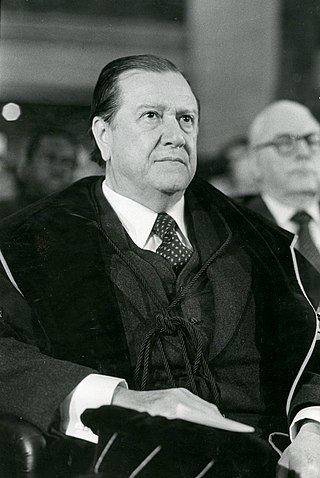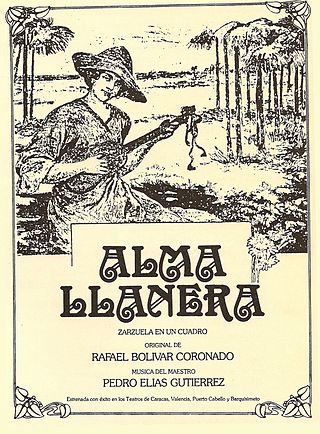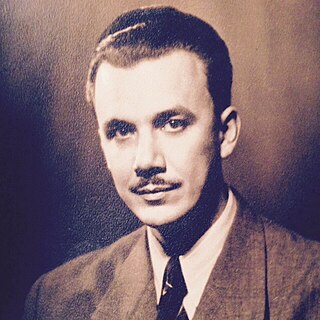Eugenio Mendoza Goiticoa (Caracas, November 13, 1906, Caracas, October 17, 1979) was a Venezuelan business tycoon who made important contributions in the modernization of the country during the 20th Century.
Eugenio Mendoza Goiticoa (Caracas, November 13, 1906, Caracas, October 17, 1979) was a Venezuelan business tycoon who made important contributions in the modernization of the country during the 20th Century.
He was the son of Eugenio Mendoza Cobeña (the grandson of Venezuela's first president, Cristóbal Mendoza) and Luisa Goiticoa (the great-granddaughter of Simón Bolívar's sister, Juana Bolívar). Despite his family's historical position he grew up in modest circumstances [1] due to the monetary sacrifices made by his family during the war for Venezuelan independence and later the Venezuelan civil war.
Along with his brothers, Pedro, Carlos, and Eduardo Mendoza Goiticoa, he was a descendant of Simón Bolívar's sister, Juana Bolívar (Simón Bolívar had no children). [1]
Eugenio married Luisa Rodriguez Planas in 1938, and had four children with her: Eugenio Andres, Gertrudis, Luisa Elena and Eugenio Antonio. One son, Eugenio Andres, drowned as a youngster. [2]
Eugenio Mendoza was the fourth son of seven children, he had four brothers and two sisters and was the only one who did not pursue a university education, choosing instead to go into business by starting his first company at the age of eighteen. In partnership with Moises Miranda [3] he founded “Moisés Miranda & Cía” a firm to sell construction materials. By January 1932, he purchased Miranda’s shares, becoming the sole owner of the company today known as “Materiales Mendoza” ”. [4] During the following years, he founded "Maquinarias Mendoza" a heavy equipment company.
He held negotiations with Vice President of the United States Henry A. Wallace, the U.S State Department and Nelson Rockefeller to commercialize construction materials in Venezuela. By that time, all construction supplies were destined to World War II.[ citation needed ]
By 1943, he had created "Venezolana de Cementos" which became the largest supplier of cement in the country. Vencemos had plants in Barquisimeto, Maracaibo, Pertigalete, Macuro and Catia La Mar. Also, in the following years he conformed "Protinal", dedicated to the production of animal feed which later became the pioneer in the development of poultry as a low cost substitute for protein; "Venezolana de Pinturas" and "Venezolana de Pulpa y Papel".[ citation needed ]
His business organization, "El Grupo Mendoza" became the largest industrial conglomerate in the 1970s encompassing everything from cement, construction, heavy machinery, paint, paper mills, animal feed, poultry, banking, and insurance to car manufacturing today known as General Motors of Venezuela.[ citation needed ]
At the age of 34, Eugenio Mendoza was appointed Minister of Industry Promotion [5] during Isaías Medina Angarita’s presidency in Venezuela (1941-1945). Arturo Uslar Pietri and Lorenzo Mendoza Fleury were also part of Medina Angarita’s cabinet; Uslar Pietri as Secretary of the Presidency and Mendoza Fleury as Philadelphia’s Consul and later as Deputy Ambassador to the United Nations. These group promoted the industrialization in Venezuela, favoring the development of the country.[ citation needed ]
In 1958 was appointed as minister of rear admiral Wolfgang Larrazabal’s cabinet following the overthrow of Marcos Pérez Jiménez on 23 January 1958.[ citation needed ]
He founded the "Fundación Mendoza" which led the philanthropic community of Venezuela for two decades primarily focusing on the founding of "Hospital Ortopedico Infantil" the largest children's hospital in Latin America and numerous schools.[ citation needed ]
In 1970, he founded the Universidad Metropolitana, a private university located in Caracas, which became the most important passion of his later years. It was the first Venezuelan university to offer careers in business management and finance. It remains one of the most prestigious private universities in Venezuela.[ citation needed ]
Today, their three children and grandchildren continue the business and philanthropic work of "El Grupo Mendoza" and "Fundación Mendoza".[ citation needed ]

Rafael Antonio Caldera Rodríguez, twice elected the president of Venezuela, served for two five-year terms, becoming the longest serving democratically elected leader to govern the country in the twentieth century. His first term marked the first peaceful transfer of power to the opposition in Venezuela's history.
"Gloria al Bravo Pueblo" is the national anthem of Venezuela. Its lyrics were written by physician and journalist Vicente Salias in 1810, set to music later composed by musician Juan José Landaeta. Owing to musical similarities with the French national anthem, beginning in 1840 "Gloria al Bravo Pueblo" was known as "La Marsellesa Venezolana". It was declared Venezuela's national anthem by decree of President Antonio Guzmán Blanco on May 25, 1881.

Several styles of the traditional music of Venezuela, such as salsa and merengue, are common to its Caribbean neighbors. Perhaps the most typical Venezuelan music is joropo, a rural form which originated in the llanos, or plains.

Arturo Uslar Pietri was a Venezuelan intellectual, historian, writer, television producer, and politician.

The Palacio de Miraflores is the official residence of the President of Venezuela. It is located on Urdaneta Avenue, Libertador Bolivarian Municipality in Caracas.

Corporación Venezolana de Televisión or VTV is a state-run television station based in Caracas, Venezuela, which can be seen throughout the capital and surrounding areas on channel 8. Programs that can be seen on VTV included Aló Presidente and Telesur Noticias.

The Central University of Venezuela is a public university located in Caracas, Venezuela. The university is widely regarded as the highest ranking institution in the country. Founded in 1721, it is the oldest university in Venezuela and one of the oldest in the Western Hemisphere. It is ranked 18th among the universities in Latin America.
Leopoldo Sucre Figarella was a Venezuelan politician and engineer of Corsican ancestors. A member of the Sucre family Sucre Figarella served as governor, minister and senator during his long and eventful political career. He was nicknamed "The Builder" and "The Czar of Guayana".

José Cristóbal Hurtado de Mendoza y Montilla, commonly known as Cristóbal Mendoza, was a Venezuelan lawyer, politician, writer, and academic. Cristobal is best known for serving as the first official President of Venezuela from 1811 to 1812. After earning a master's degree in philosophy in Caracas and his doctor utriusque juris in the Dominican Republic, early in his professional career he served in various law firms in Trujillo, Mérida, and Caracas. He moved to Barinas in 1796 to practice law, and in 1807 was elected Mayor of Barinas. In 1810, Mendoza joined the insurgent movement started by wealthy Caracan citizens against the Spanish crown, and in 1811 was elected to represent the province of Barinas in the newly founded Constituent Congress of Venezuela. Days later he was appointed the first president of the First Republic of Venezuela, a role he shared as part of a triumvirate. Until his term ended in March 1812, Mendoza began the war for independence against the parts of Venezuela that still supported the Spanish monarchy, authored the Venezuelan Declaration of Independence, and also took part in constructing the first Constitution of the Republic of Venezuela.

Eduardo Mendoza Goiticoa was a Venezuelan scientific researcher and agricultural engineer. He served the government of Rómulo Betancourt, becoming the youngest cabinet minister in Venezuelan history at the age of 28. His appointment was problematic due to his young age and required a constitutional amendment. Betancourt had insisted on the appointment and vastly expanded the portfolio of the Secretary of Agriculture to include all immigration matters.

Immigration to Venezuela historically has been significant. Because of the Venezuelan geographical location as a gateway to South America, this nation has been the plot for many newcomers, even taking place before Columbus' discovery in 1498 when many aboriginal inhabitants came and left Venezuela. After the Spanish colonization of the Americas brought European colonists and African slaves, immigration to Venezuela was significant particularly in the period after World War II, with large numbers of immigrants from Asia and Europe, particularly southern Europe. In addition, Venezuela shares a 1000-mile border with Colombia and has long had substantial numbers of Colombian residents. Since the 1980s, the Colombian conflict has seen largescale Colombian immigration, with Venezuela the number one destination for displaced Colombians.

Alicia Pietri Montemayor was a public figure in Venezuela who twice served as First Lady of Venezuela as the wife of Venezuelan president Rafael Caldera. She was the founder of the Children's Museum of Caracas. She served as president of the Children’s Foundation in Venezuela, and was also involved in other organizations dedicated to childcare.
José Herrera Uslar was the son of José Manrique and Carolina Herrera Uslar Urbaneja, one of the founding families of the Valley of Caracas and owners of the Hacienda la Vega.

Mauricio García Araujo was a Venezuelan economist who worked in both the private and public sectors. He was the president of the Central Bank of Venezuela between 1987 and 1989 during the presidency of Jaime Lusinchi (1984-1989).

Carlos Eduardo Stolk Mendoza was a lawyer, diplomat and business magnate who is well-known for his role as a delegate during World War II, as a founding representative of the United Nations and as chairman to various of its strategic committees. Stolk contributed to the establishment of the State of Israel after voting in favor of Resolution 181 (1947) of the UN.
Dr. César González Martinez was a Venezuelan lawyer. He also served as Minister of the Interior and Justice.
Basque Venezuelans are citizens of Venezuela who are of Basque ancestry.

The Sabana Grande district is divided into several middle class neighborhoods located in the Parroquia El Recreo of the Libertador Municipality, in the geographical center of the Metropolitan District of Caracas and owes its name to the old town of Sabana Grande.

The Ministry of Economy and Finance is a ministry of the government of Venezuela with similar portfolios dating back to 1810 with the creation of a tax office. When Gran Colombia was dissolved and Venezuela assumed its independence, the Ministry of Finance was created in 1830 when General José Antonio Páez commissioned the establishment of the public business office to three Secretariats of State: Interior, Justice and Police, War and Navy, Finance, and Foreign Relations. The current minister has been Delcy Rodríguez since September 2020.
{{cite web}}: CS1 maint: archived copy as title (link){{cite web}}: CS1 maint: archived copy as title (link)